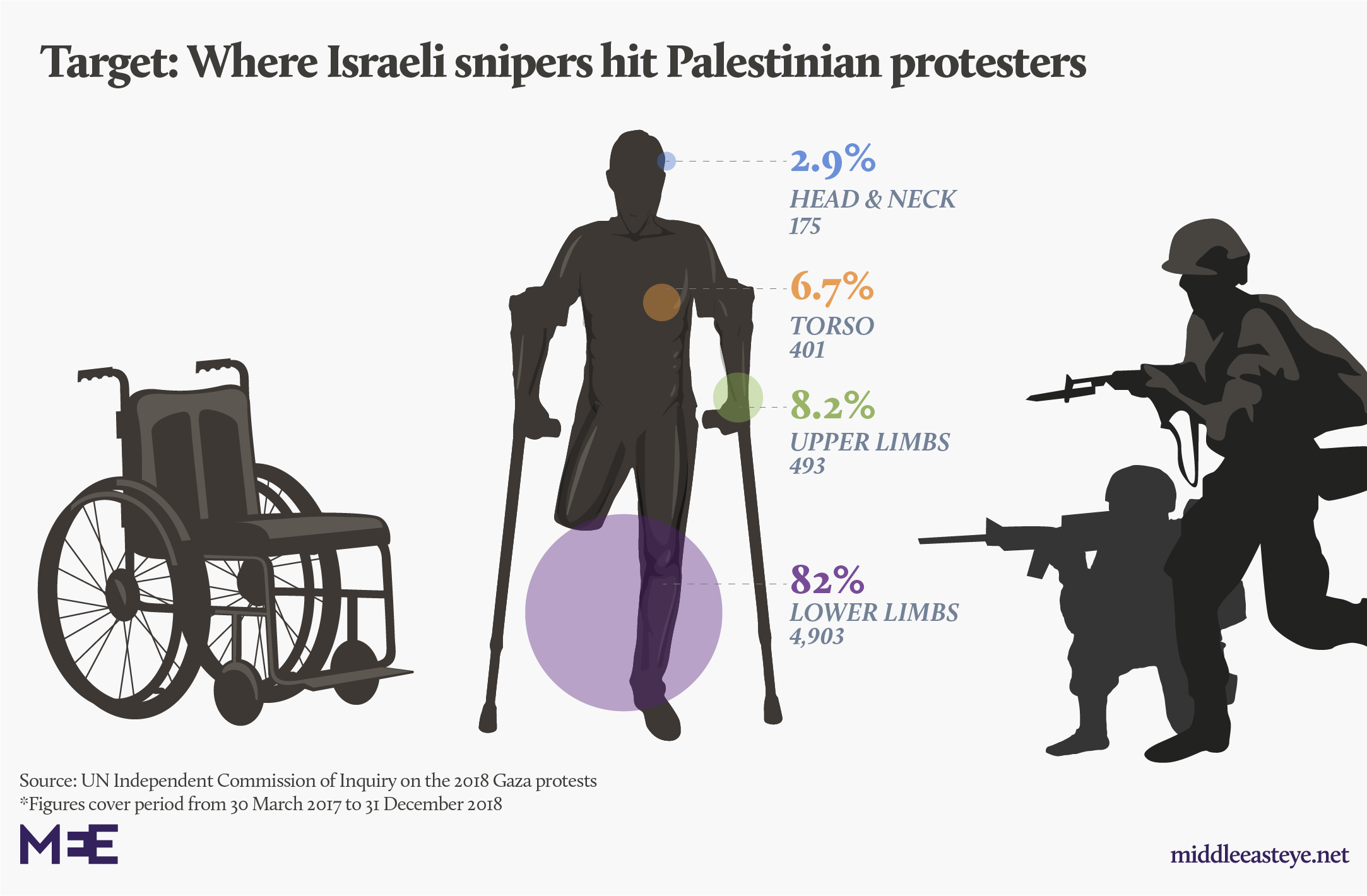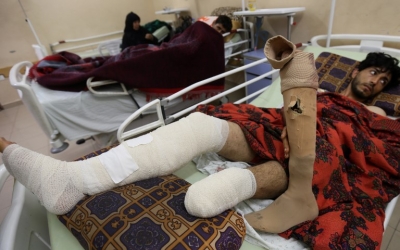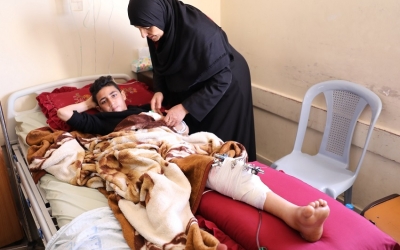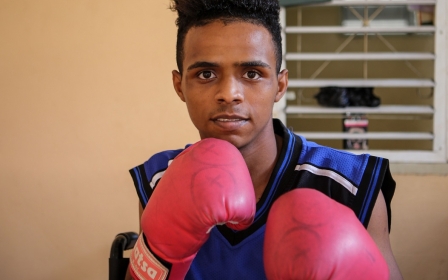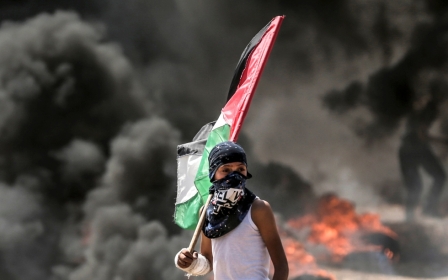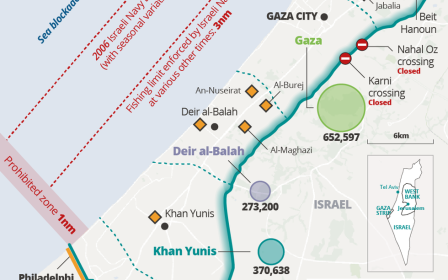'Shoot to maim': How Israel created a generation on crutches in Gaza
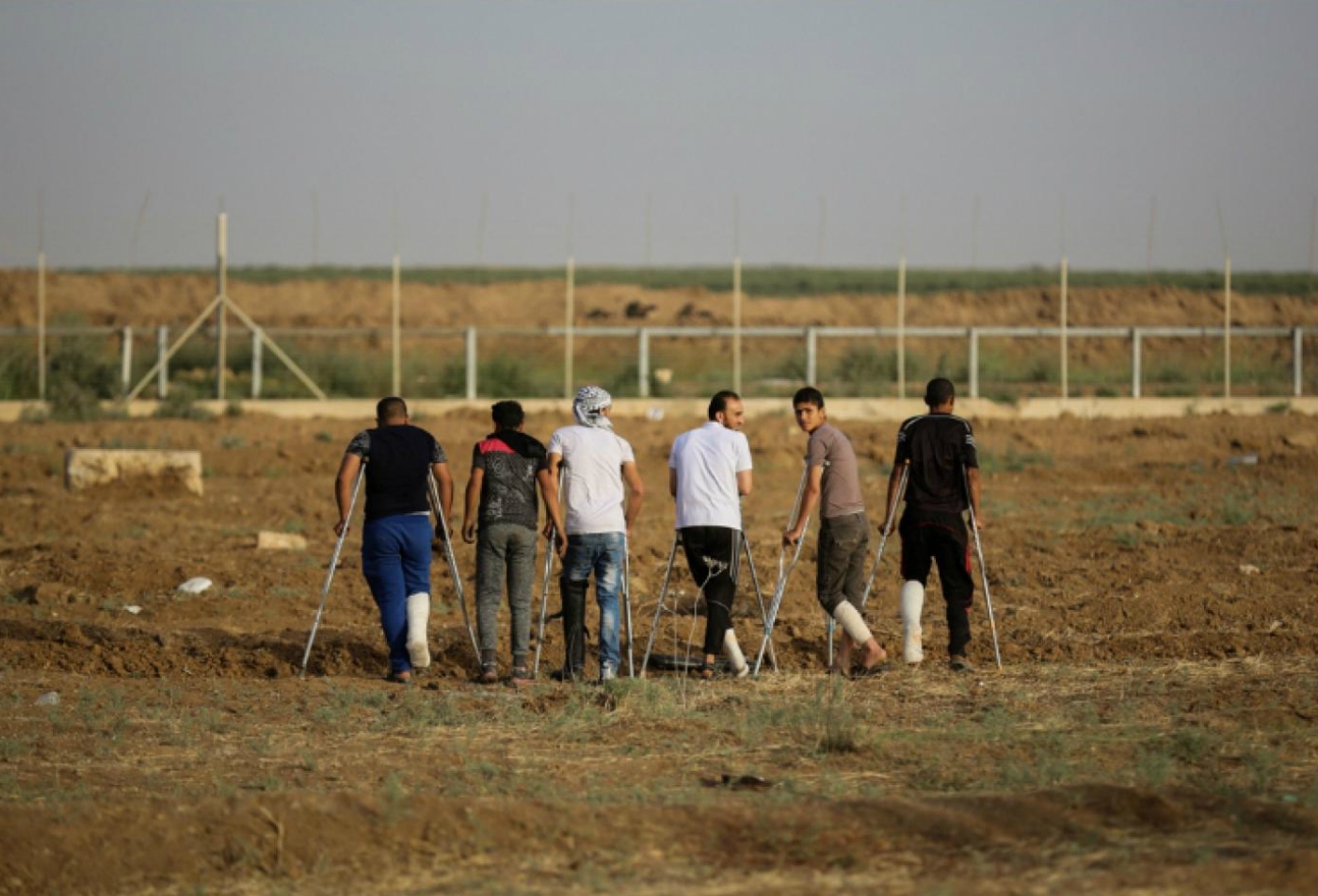
Israeli snipers have intentionally maimed Palestinians protesting in Gaza over the past year, creating a generation of disabled youth and overwhelming the territory's already crippled medical system, frontline doctors tell Middle East Eye.
According to a United Nations inquiry released this month, over 80 percent of the 6,106 protesters wounded in the first nine months of the Great March of Return were shot in the lower limbs.
Israeli soldiers intentionally shot civilians and may have committed war crimes in their heavy-handed response to the protests, which have been held regularly across Gaza since 30 March 2018, the report concluded.
Healthcare providers say the pattern of wounds shows that Israeli soldiers are purposefully shooting to maim protesters, most of whom are in their 20s and now require long-term medical care.
"The soldier knows exactly where he's putting the bullet. This is not random. This is very intimate. This is very planned," said Ghassan Abu Sitta, professor of surgery at the American University of Beirut (AUB), who treated injured protesters for three weeks at Gaza's Al-Awda Hospital last May.
"When you have such a huge number of almost identical injuries, where many of the patients were 150 metres away, not in direct contact with the Israeli soldiers, you realise that this is an intentional policy rather than collateral damage," Abu Sitta told MEE.
Marie-Elisabeth Ingres, the head of mission for Doctors Without Borders (MSF), agreed. "This is obvious. When you have almost 90 percent of the people injured in the lower limb, it means that there is a policy to target the lower limbs," she said.
MEE asked the Israeli military if soldiers were intentionally harming protesters. Underlining the conditions that soldiers operate under - including being shot at, attempts by protesters to enter Israel, tyre burning, stone throwing and Molotov cocktails - a spokesperson told MEE by email: "The IDF uses live ammunition only as a last resort and in accordance with regulations that comply with international law." The spokesperson also directed MEE to a page of FAQs about the protests.
When you have almost 90 percent of the people injured in the lower limb, it means that there is a policy to target the lower limbs
- Marie-Elisabeth Ingres, Doctors Without Borders
Among the more than 6,000 wounded Palestinians is a footballer whose career was ended, a student journalist whose right leg was amputated, and a 16-year-old schoolgirl who was waving a Palestinian flag when she was shot.
At least 136 of have had their limbs amputated, according to the latest Gaza Ministry of Health data - 122 of those amputations have been of lower limbs alone.
But the figures don't give a full picture of the challenges that the wounded protesters, suffering painful injuries, and their families face, as the vast majority live in poverty, said Dr Bassem Naim, who served as Gaza's minister of health from 2006 to 2012.
"To be honest, it is catastrophic. Of those wounded, many of them are handicapped forever," Naim said. "To bring them from the house to the hospital every two days for rehabilitation or care? It is a very, very huge burden."
"I live on the ninth floor and, at least every day for 12 to 16 hours, I don't have electricity. Can you imagine if you are a young man without a leg?"
Not only have the lives of thousands of protesters and their families been changed, but Gaza's struggling medical system is also under severe strain as a result of the intensive care required to treat leg wounds.
With mass demonstrations planned this weekend to mark one year since the beginning of the Great March of Return, health professionals fear the system's breaking point may be just around the corner.
Patterns of injury
On 30 March 2018, tens of thousands of Palestinians protested along Gaza's 65-km boundary with Israel, pressing for the right of return to homes from which their families fled in 1948 and an end to an 11-year siege on the coastal Palestinian territory.
Almost as soon as the protests started, Israeli soldiers began shooting demonstrators at close range with sniper rifles. By the end of that first day of protests, 16 Palestinians had been killed and at least 400 others were wounded by gunfire.
What was supposed to be a six-week campaign has since stretched into a year, over which time at least 197 Palestinians have been killed and 29,000 injured. Two Israelis were killed and 56 injured in the same period, according to the UN.
One out of every four injured Palestinians has been shot with live ammunition, and the vast majority have been hit in the legs.
One of them was 31-year-old Mohammed al-Akhras.
Akhras, who was employed as an iron worker, said he decided to join the protests after being tortured during six years of detention in Israeli prisons.
He was 19 when he was hunting for birds on the eastern borders of Rafah, in southern Gaza, when Israeli forces arrested him and accused him of being involved in military operations with armed Palestinian factions.
He was released in 2013, but the memories and frustrations stemming from his arrest and detention pushed him to demonstrate, he said.
On 18 May, Akhras said he was protesting like others around him and wasn't doing anything special, when two explosive bullets - which explode on impact and rip through tissue and bone - struck his left leg.
He required a quick operation, but it would be two months until he could have surgery - in Egypt.
Israeli authorities would not allow him to travel through the Erez crossing for surgery in Jordan because he was a former prisoner.
If they want to break the will of the people, then they shoot with the goal of killing. But sometimes, if they don't want things to go out of control, they shoot, but they try to avoid killing people
- Bassem Naim, former Gaza health minister
"I managed to travel to Egypt after several attempts, and after the swelling in my leg reached the point of exhaustion," he said. By then, doctors were forced to amputate.
According to the UN report and as emphasised by the Israeli military spokesperson, Israeli security forces' rules of engagement allow soldiers to fire at demonstrators "as a last resort in the event of imminent threat to life or limb of Israeli soldiers or civilians".
But international doctors and Palestinians who spoke with MEE said they witnessed protesters who were shot even when they did not threaten soldiers.
Naim, the former Gaza health minister, said he was at the protest on 8 February with his 14-year-old son and a group of friends. Nearby, a friend of the boys' was chewing on sunflower seeds and watching the demonstration, about 100 or 150 metres from the fence with Israel.
"Suddenly, they saw a child [who had been eating sunflower seeds] that had fallen down, and when they ran to him, they found a pool of blood around him and he was shot in the neck,” he said.
"I can send you hours of videos of cultural activities [at the protests] and, at the same time, you will see a few especially young people trying to throw stones or penetrate the fence. Okay, but I can say in 99.9 percent of the cases, there was no threat to the soldiers."
While he is no longer directly involved in the medical field, Naim said he believes Israeli soldiers are intentionally maiming protesters - both based on what he has witnessed at this year's demonstrations and his experience as a doctor during the Second Intifada.
During that uprising in the early 2000s, when he was working at the Naser Hospital in Khan Younis, Naim said there were noticeable patterns to the wounds inflicted by Israeli snipers.
"On one day, you will get only legs. Another day, you get only buttocks. A third day, you get chest," he said.
"If they want to break the will of the people, then they shoot with the goal of killing. But sometimes, if they don't want things to go out of control, they shoot, but they try to avoid killing people - shooting in the legs, in the hands."
Nearly two decades later, Naim believes snipers are using same precision now at the Gaza frontier.
"I can be sure this is right because some Fridays, you have one martyr or two or three. And sometimes you have 50 or 25, because they want to exercise more pressure," he said.
Medical system on the brink
In addition to raising troubling questions about the Israeli army's tactics, the Great March of Return has put Gaza's struggling medical system under renewed focus, as thousands of injured protesters are routinely brought in for emergency treatment.
Dr Medhat Abbas, director of Al-Shifa Hospital in Gaza City, describes 14 May last year as one of the worst days the hospital has experienced.
Hours after US President Donald Trump opened the new US embassy in Jerusalem and protests erupted in Gaza in anger over the move, around 500 wounded Palestinians arrived at Al-Shifa, almost as many as the 760-bed hospital can accommodate.
Patients lay on the ground and in the corridors as surgeons, too few of them with inadequate supplies, worked around the clock in all 14 of the hospital's operation rooms.
"It was a black day in Palestinian memory," Abbas told MEE, answering questions in recorded WhatsApp messages at odd hours, too busy for a phone interview.
In Jabaliya refugee camp, Abu Sitta, the AUB surgery professor, was working at Al-Awda Hospital specifically because it was near one of the main demonstration sites.
"We knew that those numbers that we were seeing every Friday were going to increase on the day of the move of the embassy," he said.
It wasn't just Shifa that was overwhelmed: between 4pm and 8pm that day, 3,400 protesters were injured, 1,000 more than the total number of hospital beds in Gaza, Abu Sitta said.
By the end of the day, 68 people had either been killed or suffered fatal injuries to which they would later succumb.
Gaza's healthcare system was already weak as a result of the 11-year siege, which has limited the flow of medical equipment, supplies and doctors, particularly those with surgical specialities, into the territory.
But the mass casualties on days like 30 March or 14 May have left a lingering burden on Gaza's hospitals. Gunshot wounds to legs, particularly those caused by sniper bullets shot at close range, can require as many as nine periods of surgery to treat, said Abu Sitta.
What happens when sniper bullets hit legs
+ Show - HideThe damage done by a bullet is dependent on the speed at which a bullet is moving, with the kinetic energy transferred into tissue, says Ghassan Abu Sitta, professor of surgery at the American University of Beirut.
“When you use a sniper rifle – which is a military high-velocity rifle – this is the highest velocity bullet that there is because it can travel up to three kilometres,” he said.
“So when you shoot somebody at 50 metres or 100 metres, the majority of the kinetic energy is still in the bullet.”
According to Doctors Without Borders, in half of the leg wound cases they have treated in Gaza since last March, patients have had complex open fractures, meaning that bone is exposed to air and there is risk of bone infection.
Many will also have severe tissue and nerve damage and are missing huge parts of their leg bones.
One MSF doctor said in the half the cases he had seen, the bone “has literally been turned into dust”.
These types of wounds require multiple surgeries, sometimes as many as nine, said Abu Sitta.
“It means months and maybe years of treatment. So it mean they are in a lot of pain, they are suffering a lot,” said Marie-Elisabeth Ingres, MSF’s head of mission in Jerusalem.
Most of those who are wounded will have side effects for the rest of their lives including stiffness, paralysis and, for some, amputation.
"Think about the number of orthopaedic and plastic surgeons you would need to do reconstructive surgery on 80 percent of 6,500 [injured patients]," he said.
"It's beyond the human resource capacity of Gaza. It's beyond the number of available operating room hours, in terms of materials, in terms of medication, in terms of rehabilitation. And the aim is to completely overwhelm the system. There's an intention to maim."
If doctors are unable to move quickly to help the wounded, they can suffer complications for the rest of their lives, said MSF's Ingres.
"We are struggling because we are afraid that if there is not enough involvement in the response, thousands of people could be disabled," she said.
"Already 200 people have been amputated, and if we are not able to treat them tomorrow, it means among the young generation, many of them will be disabled because we will not be able to save their legs - and it is possible."
The leg wounds have also triggered concerns over antibiotic resistance in Gaza. Ingres said MSF estimates that at least 1,200 people may have developed bone infections, which require six weeks of hospitalisation and a high-level antibiotic before any surgeries.
"So we know already that the treatment will be long and very expensive," she said.
The toll on a generation
Beyond the layers of medical crisis in Gaza, say the doctors, are the long term implications of a generation of young, disabled Palestinians.
"The media will say 'two, three Palestinians dead, 500 wounded today’. But actually, these 500 have been condemned to a life of disablement, of economic unproductivity, and years of painful surgery," said Abu Sitta.
"It is also a psychological problem," added Ingres, "because now the young people understand that it will be very difficult for them."
"They just wanted to demonstrate for the majority of them to show that they have the right to exist like everybody in the world. And today, after one year, what do they have? They have nothing."
Ingres said the spectre of a large demonstration to mark the one-year anniversary of the Great March of Return is worrying.
"To be frank with you, if there is a new massive number of injured people, nobody will be able to manage Gaza," she said. "It will be a disaster."
But even with clear knowledge of the risks they take to protest near the frontier, young Palestinians have continued to demonstrate, with calls for a million people to join the anniversary march on Saturday.
Akhras, the 31-year-old who was shot in the leg last May, may be among those protesters, despite the fact that his life has taken a dramatic turn since he was shot.
No longer able to make money as an ironworker, Akhras had been receiving a salary from the Palestinian Authority for injured people until two months ago when it was cut, leaving him in challenging economic circumstances.
His wife, Haneen al-Qutati, 23, helps support the couple through her work as a nurse, and their first baby is due soon. Meanwhile, Akhras is training to be a woodworker through an organisation that helps disabled people.
He says he feels the ache of his injury frequently, but doesn't want to take painkillers for fear of becoming addicted. He is still without a prosthetic leg, using crutches to move around.
"I feel a lot of pain in the evening, but I try to show my wife that there is no pain," he said. "Some look at me as a pity. It is a painful feeling for my wife."
Nonetheless, he's gone out on several recent Fridays to join protests near Rafah, still determined to protest.
"I want young people to show a strong will," he said. "The occupation deliberately targets them and wants a young Palestinian generation walking on crutches."
- Additional reporting by Mohammed al-Hajjar and Ola Mossu in Gaza and Chloé Benoist in London
Middle East Eye propose une couverture et une analyse indépendantes et incomparables du Moyen-Orient, de l’Afrique du Nord et d’autres régions du monde. Pour en savoir plus sur la reprise de ce contenu et les frais qui s’appliquent, veuillez remplir ce formulaire [en anglais]. Pour en savoir plus sur MEE, cliquez ici [en anglais].


